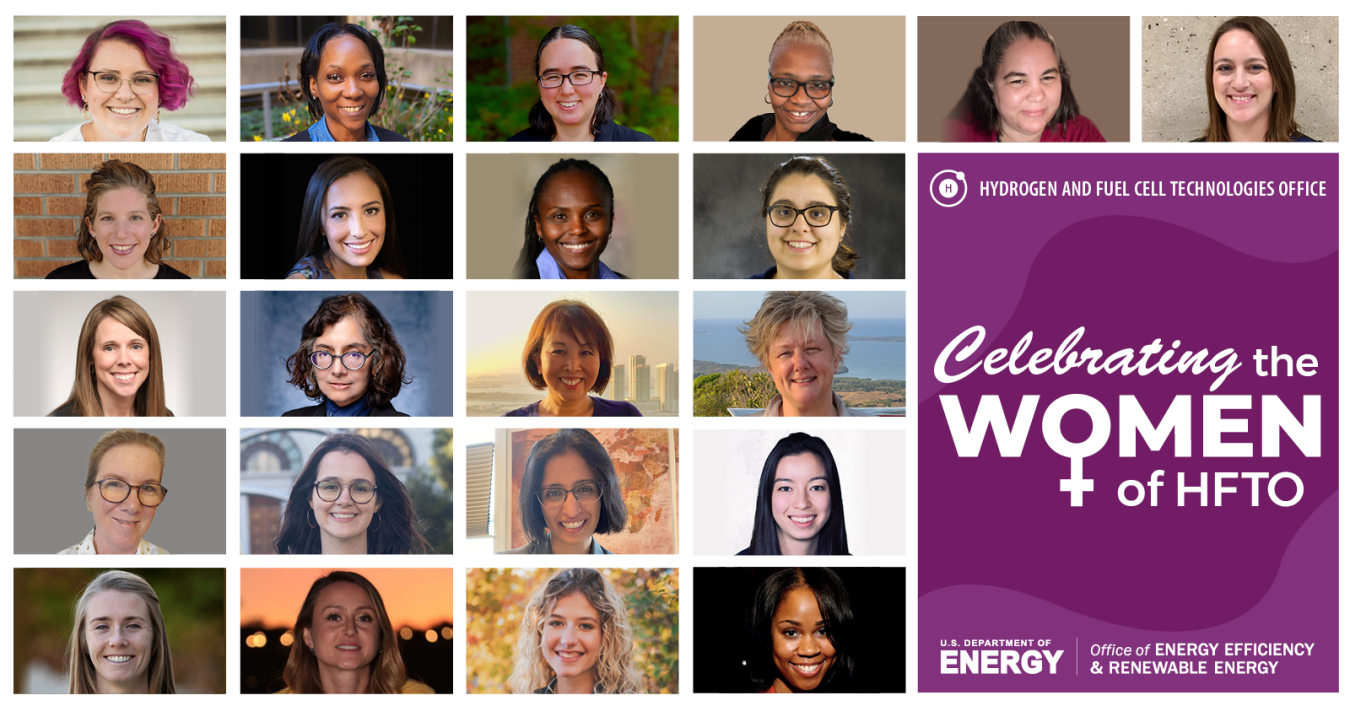In celebration of Women’s History Month, HFTO is spotlighting Dr. Sunita Satyapal, director of HFTO and DOE’s Hydrogen Program coordinator.
Hydrogen and Fuel Cell Technologies Office
March 31, 2023
The U.S. Department of Energy’s (DOE) Hydrogen and Fuel Cell Technologies Office (HFTO) is proud of the amazing women on its staff. Women currently make up about half of the office and serve in a wide range of crosscutting, technical, and creative roles, including managers, advisors, analysts, communicators, coordinators, and, notably, HFTO director. In celebration of Women’s History Month, HFTO is spotlighting Dr. Sunita Satyapal, director of HFTO and DOE’s Hydrogen Program coordinator.
Sunita is widely known for her steadfast commitment to hydrogen and fuel cells, her deep knowledge of the technologies and the industry, and her determined leadership through decades of ups and downs. In her more than twenty-five years of experience in hydrogen and fuel cells, she has worked across industry, academia, and government—from research through deployment—and has coordinated with other federal agencies and international partners to further hydrogen and fuel cell technologies. See Sunita’s full bio.
We sat down with Sunita to learn more about her work and perspective as a woman and a leader in the hydrogen and fuel cells field.
What motivates your work?
This moment is unprecedented in history, particularly for hydrogen, as we work to address the climate crisis. Hydrogen is often called the Swiss Army knife of clean energy because of its versatility. It enables our energy security and resiliency and can potentially reduce or eliminate emissions from key sectors. Many countries now realize they cannot meet climate goals without a carbon-free molecule like hydrogen, particularly for hard-to-decarbonize sectors like freight and heavy industry. And fuel cells can provide efficient, zero-emissions power for stationary and transportation applications. Hydrogen and fuel cells have been the energy underdog for so long, but the community has the tenacity and wherewithal to address the challenges. We need “all hands on deck” to be as efficient, productive, and effective as possible as we develop and deploy these solutions. I’m motivated by the technical challenges and need for a cohesive, coordinated strategy and an inclusive, collaborative execution plan.
What outreach opportunities to promote women in hydrogen have you taken part in?
I’m so proud of my colleagues within HFTO—they are so dedicated and talented and such an inspiration and honor to work with. They make my day, every day. There are numerous examples of outreach events that include women in leading and organizing roles, including: the ride-and-drive with a fuel cell car we just hosted for Women’s History Month; the Early Career Network of the International Partnership for Hydrogen and Fuel Cells in the Economy (IPHE) with members from over 38 countries, promoting networking and opportunities for students, postdocs, and early career professionals working in hydrogen and fuel cells; the National Hydrogen and Fuel Cell Day events on October 8 in honor of the atomic weight of hydrogen (1.008); and many others. I was also honored to participate in an event hosted by the Clean Energy Education and Empowerment (C3E) Initiative and in various Women in Hydrogen events with many amazing colleagues.
How do you think things have changed for women in the hydrogen field since you started your career?
One change I have seen—not just for hydrogen, but in the field of clean energy in general—is that there are more women in high-level positions. We are so fortunate to have exceptional women leading the charge—starting at the very top with Jennifer Granholm, the former governor of Michigan and only the second woman to serve as Secretary of Energy. She is truly inspirational and has rallied the public and private sectors around a shared sense of urgency and action. Several undersecretaries, assistant secretaries, and deputy assistant secretaries are also women. We still need to provide opportunities and ideas to help women during challenging times in their lives, including when caring for young children. We can also support spouses or partners that take on the role of stay-at-home parent or juggle their careers to allow the women in their lives to fulfill their career aspirations without the pressure of staying home.
What barriers still exist for women?
One of the perennial challenges is the lack of time and balancing the pressures of home life and work demands. Women also tend not to speak up as often in meetings and are still treated differently than their male counterparts, even if they articulate the exact same point of view. Effective presentation skills and learning how to address issues like “mansplaining” are examples of how we can overcome some of the challenges. Some of these challenges are not gender-specific, and it’s important to provide mentoring and other networks to share ideas and be as inclusive as possible.
What advice would you give to young women wanting to pursue a career in hydrogen?
Perseverance and flexibility—along with a willingness to embrace both depth and breadth—are all crucial since hydrogen has potential across diverse applications. I’ve often said that “you can’t build a treehouse without a tree”—you need a solid foundation, whether that’s an understanding of electrochemistry, analytical skills, or experience with community engagement. The field is moving so quickly, and it’s important to avoid ending up in a cul-de-sac. Learn as much as possible, and feel free to start with the DOE Hydrogen Program’s Annual Merit Review, where we showcase hundreds of projects funded by DOE and other agencies. DOE and its national lab partners also provide opportunities for professional development through internships, fellowships, and post-doctorate positions.

